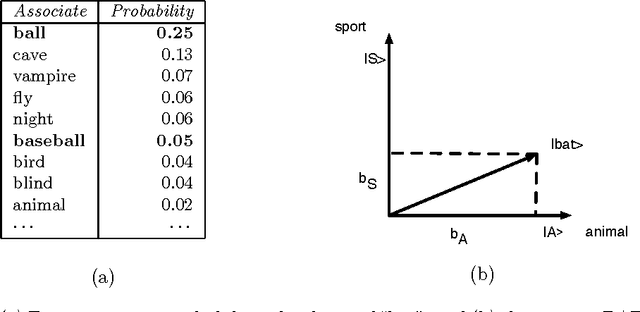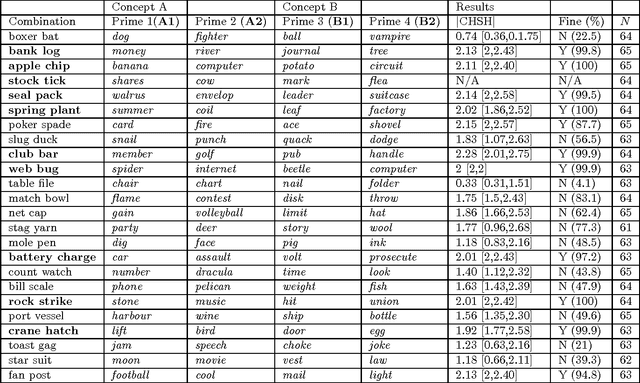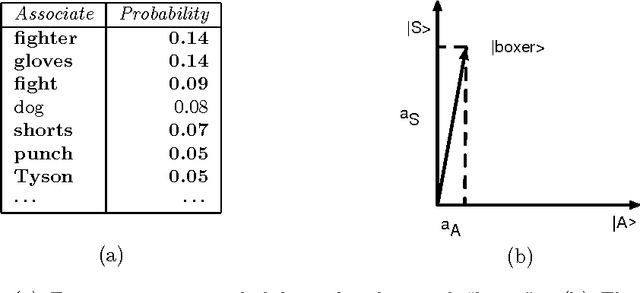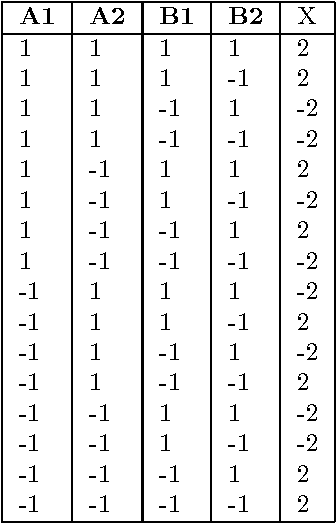Peter D. Bruza
Distributed Systems Technology Centre
Modelling contextuality by probabilistic programs with hypergraph semantics
Jan 31, 2018Abstract:Models of a phenomenon are often developed by examining it under different experimental conditions, or measurement contexts. The resultant probabilistic models assume that the underlying random variables, which define a measurable set of outcomes, can be defined independent of the measurement context. The phenomenon is deemed contextual when this assumption fails. Contextuality is an important issue in quantum physics. However, there has been growing speculation that it manifests outside the quantum realm with human cognition being a particularly prominent area of investigation. This article contributes the foundations of a probabilistic programming language that allows convenient exploration of contextuality in wide range of applications relevant to cognitive science and artificial intelligence. Specific syntax is proposed to allow the specification of "measurement contexts". Each such context delivers a partial model of the phenomenon based on the associated experimental condition described by the measurement context. The probabilistic program is translated into a hypergraph in a modular way. Recent theoretical results from the field of quantum physics show that contextuality can be equated with the possibility of constructing a probabilistic model on the resulting hypergraph. The use of hypergraphs opens the door for a theoretically succinct and efficient computational semantics sensitive to modelling both contextual and non-contextual phenomena. Finally, this article raises awareness of contextuality beyond quantum physics and to contribute formal methods to detect its presence by means of hypergraph semantics.
A probabilistic framework for analysing the compositionality of conceptual combinations
Nov 21, 2014



Abstract:Conceptual combination performs a fundamental role in creating the broad range of compound phrases utilized in everyday language. This article provides a novel probabilistic framework for assessing whether the semantics of conceptual combinations are compositional, and so can be considered as a function of the semantics of the constituent concepts, or not. While the systematicity and productivity of language provide a strong argument in favor of assuming compositionality, this very assumption is still regularly questioned in both cognitive science and philosophy. Additionally, the principle of semantic compositionality is underspecified, which means that notions of both "strong" and "weak" compositionality appear in the literature. Rather than adjudicating between different grades of compositionality, the framework presented here contributes formal methods for determining a clear dividing line between compositional and non-compositional semantics. In addition, we suggest that the distinction between these is contextually sensitive. Utilizing formal frameworks developed for analyzing composite systems in quantum theory, we present two methods that allow the semantics of conceptual combinations to be classified as "compositional" or "non-compositional". Compositionality is first formalised by factorising the joint probability distribution modeling the combination, where the terms in the factorisation correspond to individual concepts. This leads to the necessary and sufficient condition for the joint probability distribution to exist. A failure to meet this condition implies that the underlying concepts cannot be modeled in a single probability space when considering their combination, and the combination is thus deemed "non-compositional". The formal analysis methods are demonstrated by applying them to an empirical study of twenty-four non-lexicalised conceptual combinations.
Applying Maxi-adjustment to Adaptive Information Filtering Agents
Mar 08, 2000



Abstract:Learning and adaptation is a fundamental property of intelligent agents. In the context of adaptive information filtering, a filtering agent's beliefs about a user's information needs have to be revised regularly with reference to the user's most current information preferences. This learning and adaptation process is essential for maintaining the agent's filtering performance. The AGM belief revision paradigm provides a rigorous foundation for modelling rational and minimal changes to an agent's beliefs. In particular, the maxi-adjustment method, which follows the AGM rationale of belief change, offers a sound and robust computational mechanism to develop adaptive agents so that learning autonomy of these agents can be enhanced. This paper describes how the maxi-adjustment method is applied to develop the learning components of adaptive information filtering agents, and discusses possible difficulties of applying such a framework to these agents.
 Add to Chrome
Add to Chrome Add to Firefox
Add to Firefox Add to Edge
Add to Edge